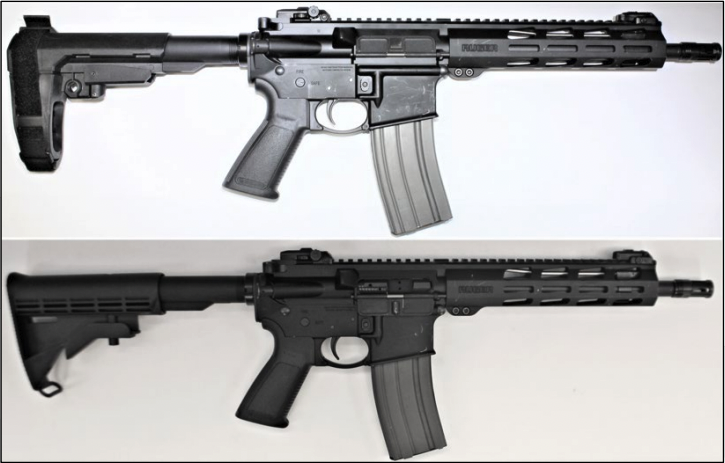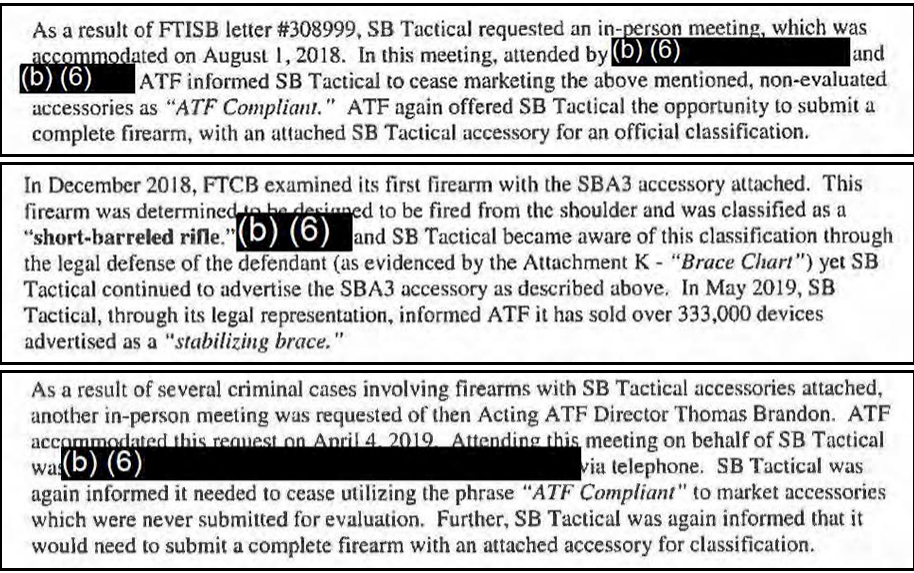Documents obtained via a Freedom of Information Act (FOIA) request to the Bureau of Alcohol, Tobacco, Firearms and Explosives (ATF) indicate that SB Tactical, the largest provider of pistol stabilizing braces — or simply “arm braces” — may have been deceiving customers about its products.
Co-founded by Alex Bosco, who invented the first arm brace in 2012 to help a disabled shooter fire an AR-15 pistol with just one hand, SB Tactical steadily grew its product portfolio to include a number of arm braces that look and are capable of operating like shoulder stocks — and have been used in at least three mass shootings. But as the newly uncovered documents show, while SB Tactical had two arm braces approved by the ATF in 2012 and 2015, the company seemingly ignored the agency when it marketed newer designs that appear similar to shoulder stocks and allowed gun owners to circumvent National Firearms Act (NFA) regulations on short-barreled rifles, or SBRs.
One of those designs is the SBA3, which is capable of functioning like a typical collapsible stock for an AR-15 in that it can be extended or retracted to adjust its length and fit a shooter’s shoulder better, unlike the two SB Tactical braces approved by the ATF in 2012 and 2015. Nevertheless, in April 2018, SB Tactical first announced the SBA3 and claimed that the “5-position adjustable SBA3 does not change the classification of the host pistol” into an SBR. But as the FOIA documents show, the company did not receive the ATF’s approval before releasing the product — or even submit an SBA3 for the ATF to review until May 2019.
In July 2018, the ATF notified SB Tactical that it must cease the “false advertisement” of 23 arm braces as being “ATF compliant” when the agency had not inspected or approved them — only the two prior SB Tactical designs from 2012 and 2015. In that letter, the ATF also noted that it “does not approve ‘stabilizing braces’ which are similar or based off shoulder stock designs.”

In addition to the mass shootings carried out with arm-braced-equipped AR-15s advertised as “pistols,” the FOIA documents reveal that the ATF examined several recovered crime guns outfitted with SB Tactical SBA3 arm braces — including four AR-15s1See “FOIA Documents” PDF, 1-7, 8-25. and two shotguns2FOIA Documents, 26-42, 43-62. between 2018 and 2020 — that the agency determined were SBRs and short-barreled shotguns, respectively. In May 2020, the ATF also examined another recovered crime gun, a Honey Badger Pistol,3FOIA Documents, 63-85. Note: While the gun’s make and model are redacted in the report, photos show the Honey Badger Pistol’s proprietary SB Tactical arm brace, and the ATF includes a photo (p.73) comparing the pistol and SBR variants that was duplicated, but left unredacted, in this ATF presentation (p. 13). that it deemed an SBR before ordering its maker, Q LLC, to cease and desist selling the model because of its similarity to the Honey Badger SBR that August.
A March 2020 letter from the ATF included in the FOIA documents indicates that SB Tactical was made aware of these findings but continued to sell its arm braces without ATF approval.4FOIA Documents, 86-155. It appears that the company also delayed sending its products to the ATF for evaluation, even after meeting in person with ATF personnel.5FOIA Documents, 87-90. It wasn’t until May 2019 that SB Tactical submitted a Ruger AR-556 pistol with an SBA3 arm brace for classification.6FOIA Documents, 90.

In that March 2020 letter, the ATF provided a lengthy analysis that ultimately classified the Ruger AR-556 pistol — the same gun that was later used by the Boulder shooter in March 2021 — as an SBR because of several factors, including the gun’s dimensions and configuration, the SBA3’s similarity to a rifle stock, and SB Tactical’s marketing materials.7FOIA Documents, 91-112. The ATF noted that the “submitted firearm with attached SBA3 accessory is consistent with firearms SB Tactical and its business partners have marketed as a way to avoid NFA registration and ‘Stiff Arm the Establishment’” and that “[m]anufacturers often refer to the SBA3 accessory as a ‘stock’ demonstrating intent to build ‘short-barreled rifles’ while avoiding NFA controls.”8FOIA Documents, 111.
In its report examining the Honey Badger crime gun, the ATF noted that it “consider[ed] many of SB Tactical’s accessories to be modified shoulder stocks and therefore shouldering devices themselves, [yet] SB Tactical has continued to market these accessories as ‘ATF Compliant Pistol Stabilizing Braces.’ Although ATF has made a consistent effort to inform SB Tactical they are perpetuating a false narrative regarding the accessories they market, SB Tactical has taken the position that ATF has no authority to regulate an accessory manufacturer. This has essential [sic] left SB Tactical’s business partners and ‘friends’ on the hook for unknowingly manufacturing and marketing unregistered NFA firearms.”9FOIA Documents, 66.
Click here to view the FOIA documents.
The documents can be seen as a roadmap for the ATF’s efforts to rein in arm braces, culminating in the final arm brace rule announced in January 2023, which included a 120-day amnesty period that ended on May 31, 2023. Since the rule was announced, several lawsuits have been filed to stop the ATF from implementing it — including one filed by SB Tactical, the Firearms Regulatory Accountability Coalition (FRAC), the NRA, and attorneys general from 25 states. Many companies have begun to remove braced weapons from their inventories, however, including Ruger, which quietly discontinued the AR-556 pistol.
On March 23, 2023, just days before the Nashville shooting was committed with a Lead Star Arms Grunt AR-15 outfitted with an SBA3 arm brace, Alex Bosco testified in front of the House Oversight and Judiciary Committees. He argued that the ATF had pulled the rug out from SB Tactical and “millions of Americans who followed ATF’s advice for the past decade” when proposing the new arm brace rule. But according to these documents, the ATF only ever approved two SB Tactical designs. The company then marketed dozens of products never approved by the ATF as “ATF compliant,” even after receiving the July 2018 cease-and-desist letter. The ATF also repeatedly warned the company that its subsequent arm braces required ATF evaluation, and informed SB Tactical that its arm braces turned some AR pistols into SBRs — all well before the ATF proposed its arm brace rule.
Bosco also claimed the ATF’s “guidance was unclear and contradictory,” as “[e]ach new letter seemed to add additional criteria for whether a particular device properly functioned as a stabilizing brace. This made it exceptionally difficult not only to keep up with compliance, but also to innovate and invest in new product development without clear rules of the road.”
But Bosco’s testimony did not mention something he acknowledged during a November 2017 interview, “that many who bought braces…did so to avoid NFA registration.”